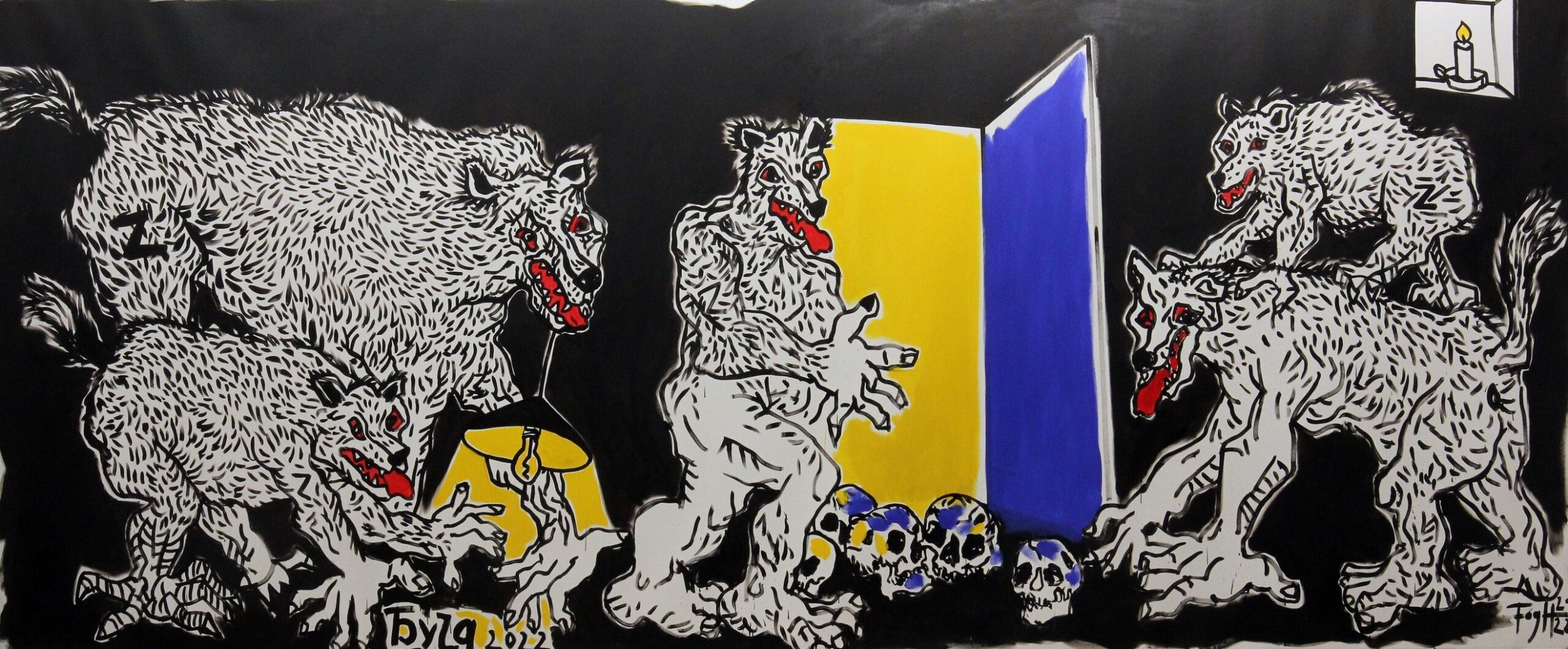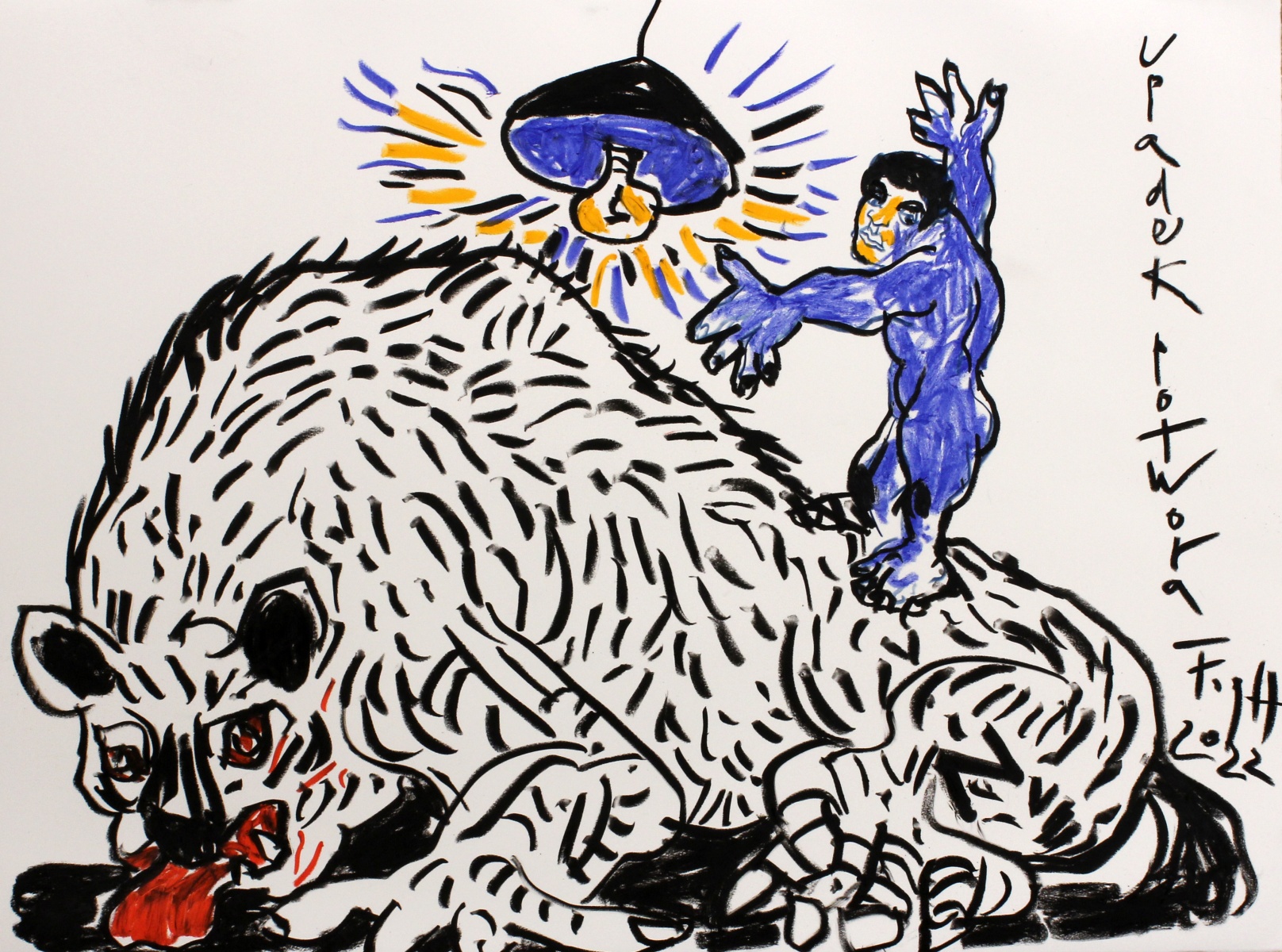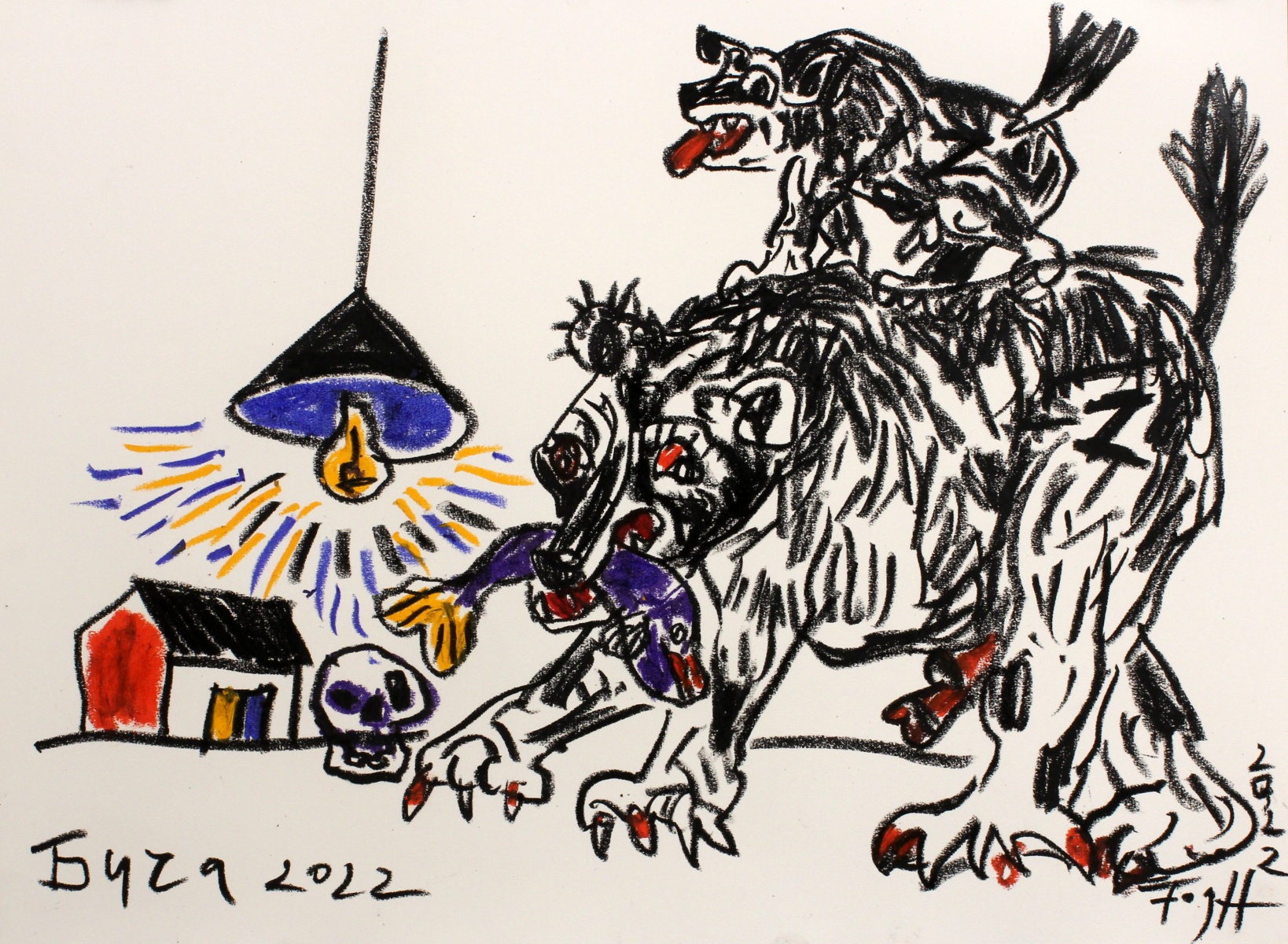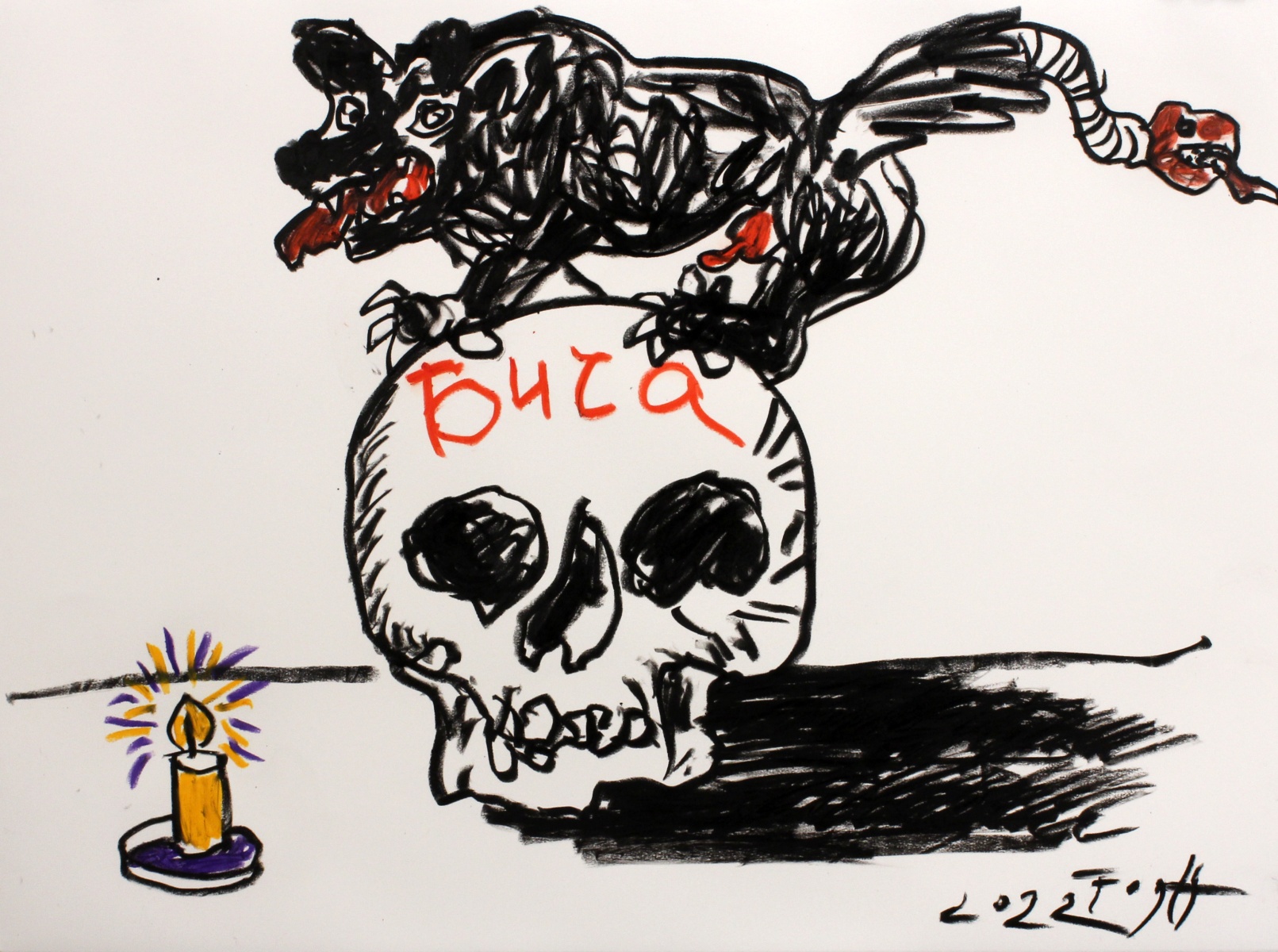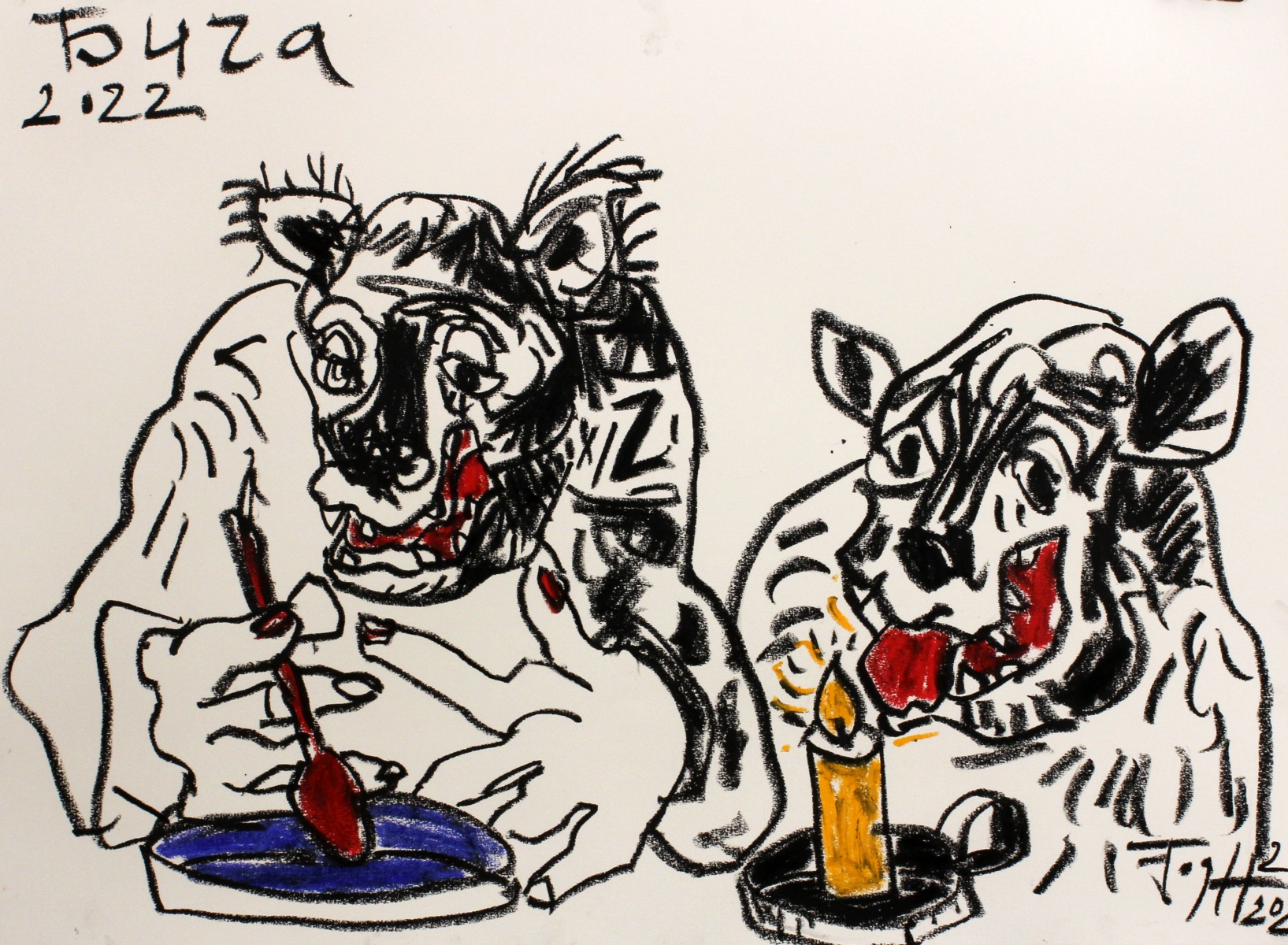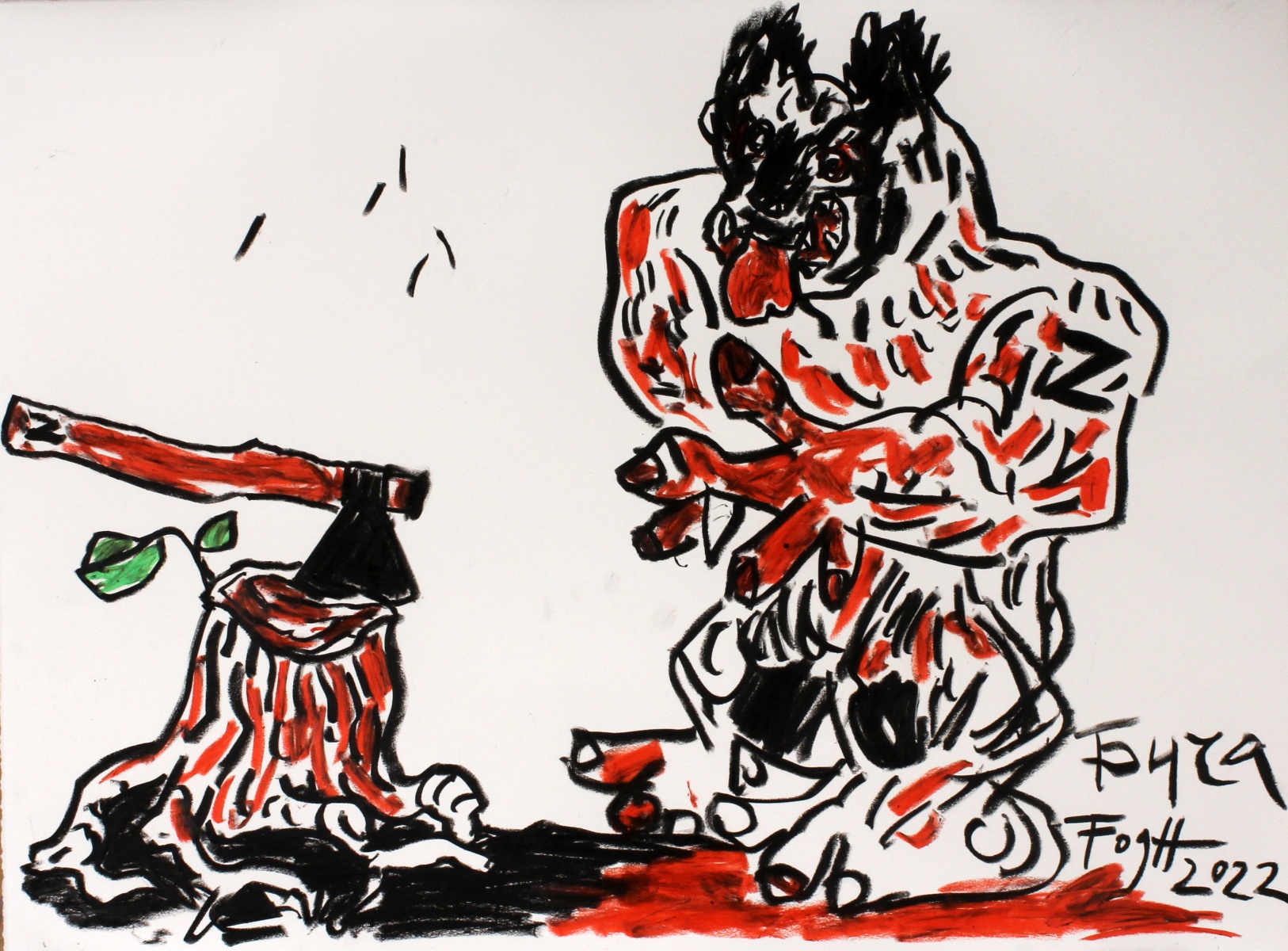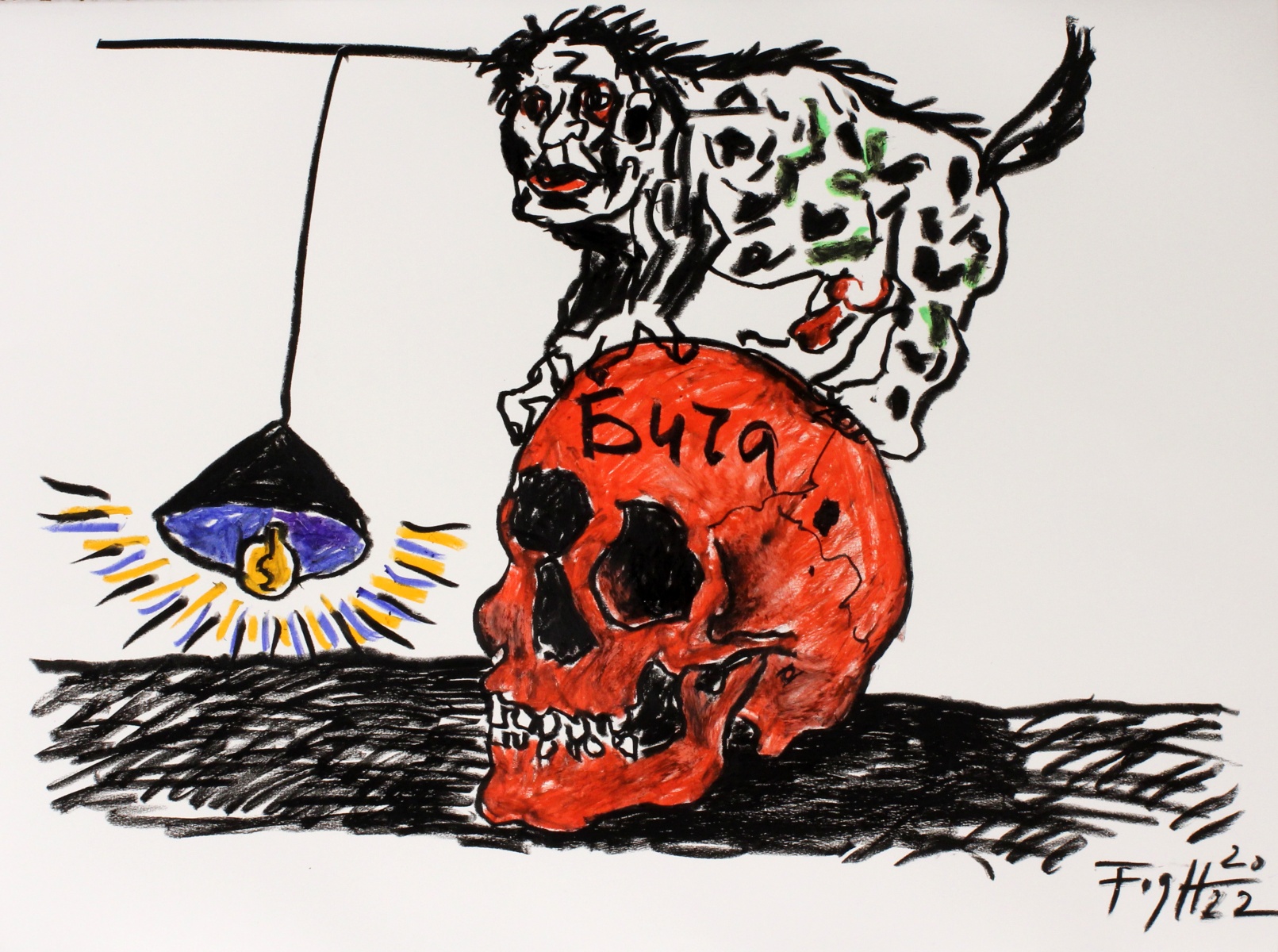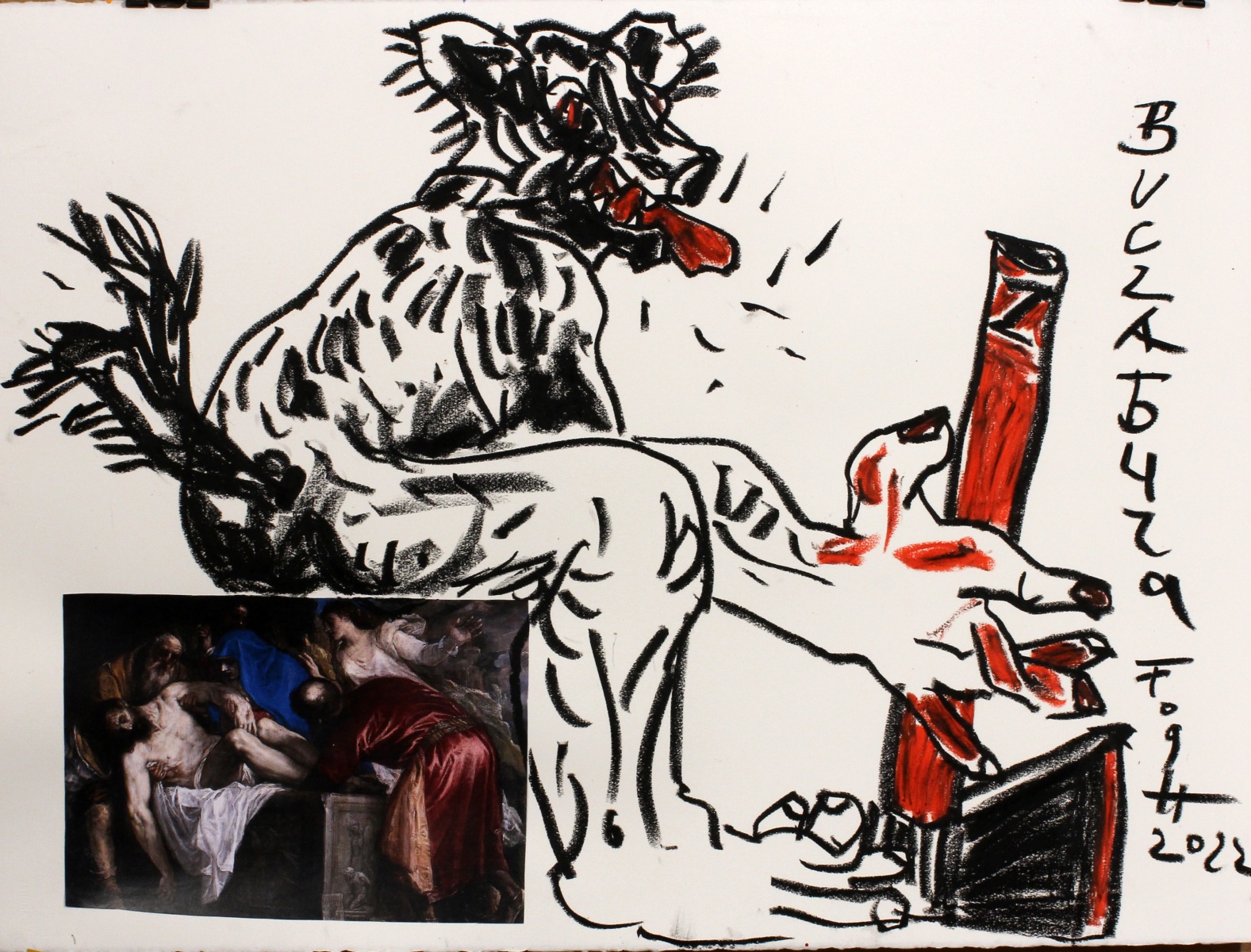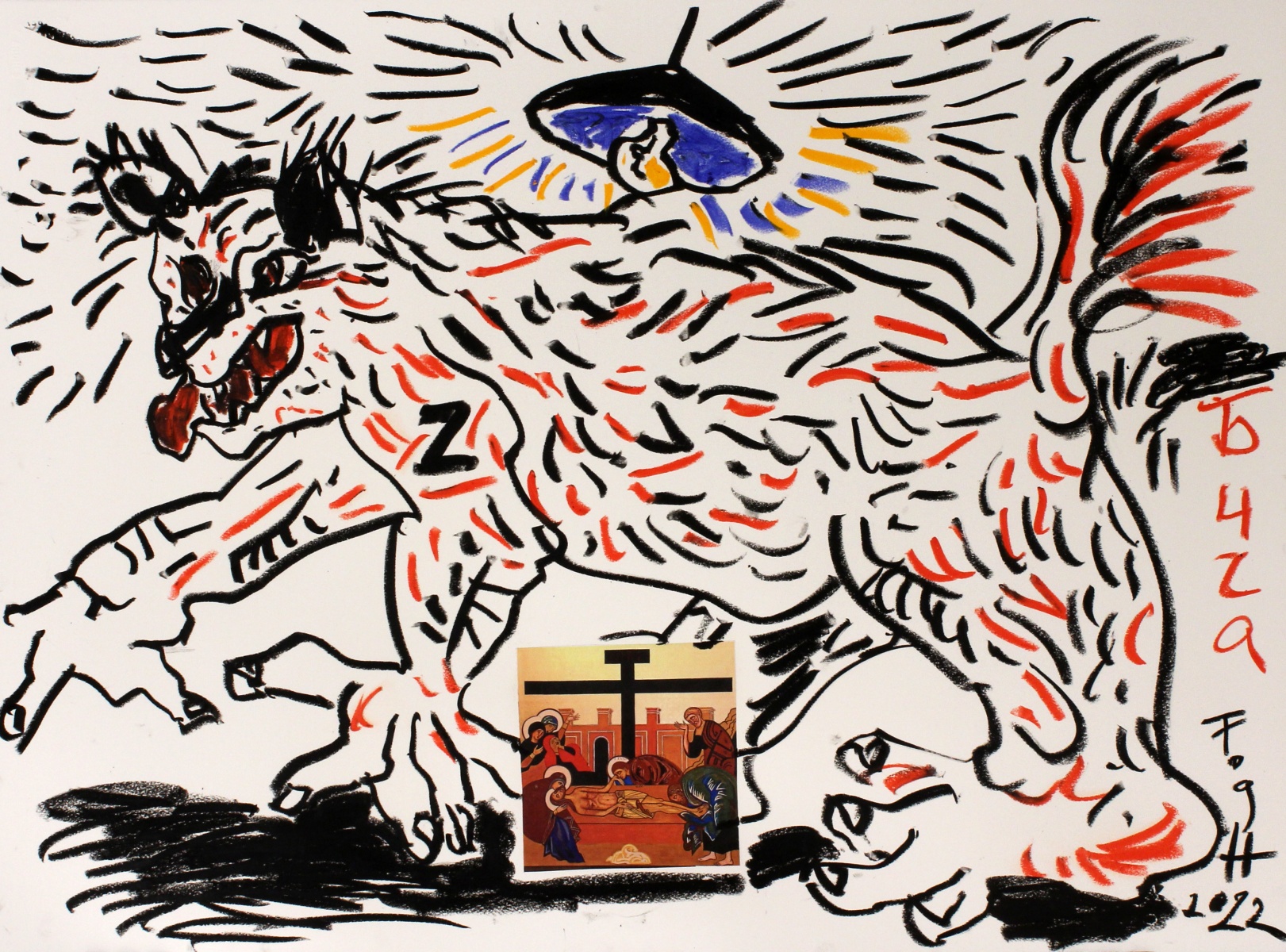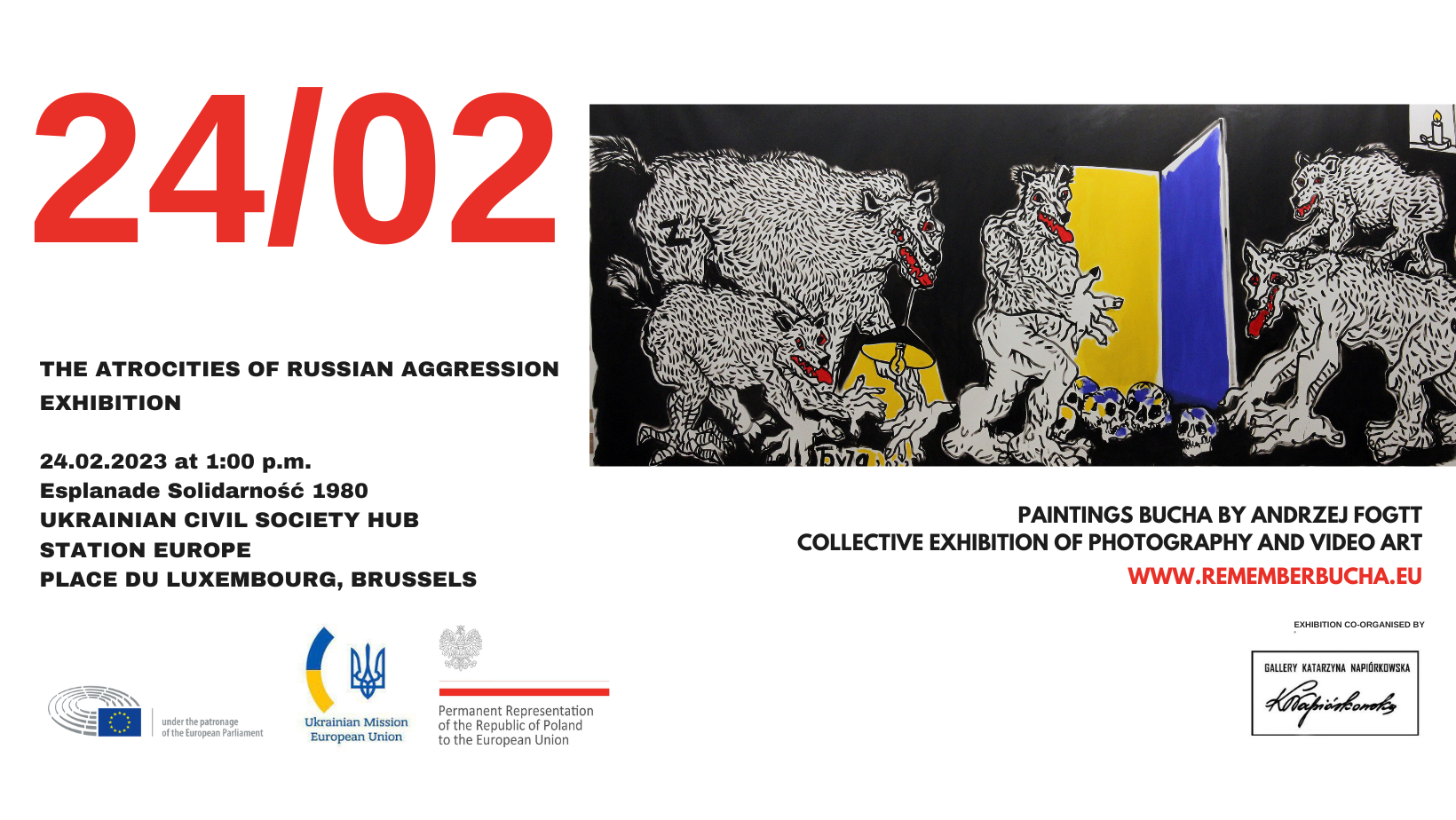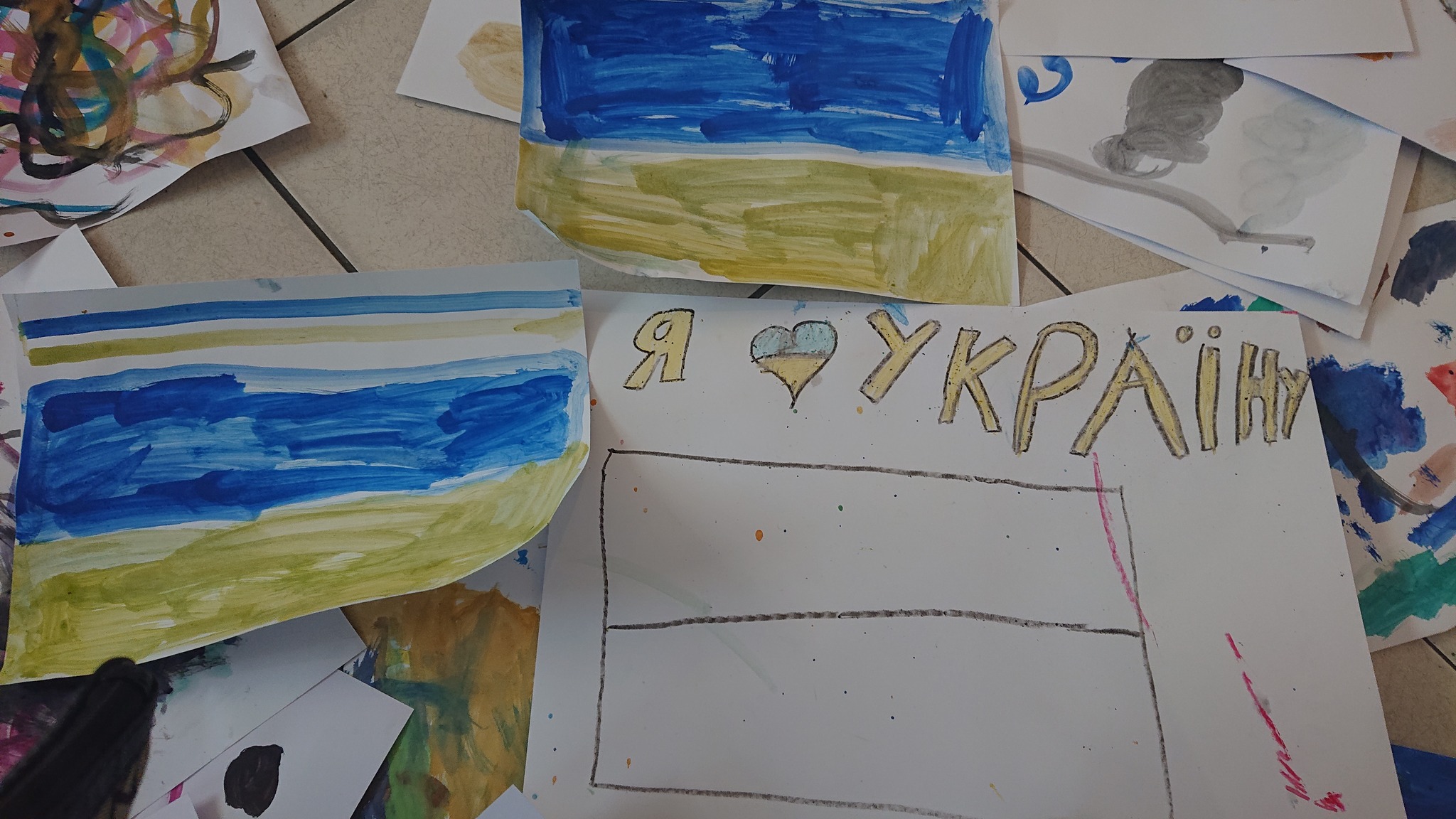Bucha. Atrocities of the Russian aggression
BRUSSELS. EUROPEAN PARLIAMENT / UKRAINIAN CIVIL SOCIETY HUB
24.02.-10.03.2023
EXHIBITION
The exhibition “Bucha. The atrocities of Russian aggression” was created as an artistic response to terrifying events. The subject of the paintings was the most important. In April 2022, over a month after Russia invaded Ukraine, the world learned about the vastness of crimes committed by Russian aggressors. In reaction, a Polish painter, Andrzej Fogtt, created a series of paintings related to Russian barbarism. At the invitation of the mission of Ukraine to the European Union and in cooperation with the Permanent Representation of the Republic of Poland to the European Union, the Gallery of Katarzyna Napiórkowska prepared an exhibition that accompanied the “anniversary” of Russian aggression against Ukraine. The exhibition is under the patronage of the European Parliament.
The exhibition consists of paintings by Andrzej Fogtt and photos and videos of selected artists from Ukraine, Poland and Romania.
War cruelty- in international law referred to as war crimes- took place in many places attacked by the Russian aggressor of Ukraine. The Russians violated all rules through brutality, rape, murder, terror and torture. The incidence of civilians became a tool of this monstrous war. Testimonies revealed brutal behaviours of invaders, but also incredible solidarity of the community of the large part of the world emerged.
The images we saw after the liberation of Bucha were a shock. The power of evil is expressed in its extreme form. Photographs of reporters, tv broadcasts, testimonies of survivors and texts of journalists- all demonstrated the vastness of cruelty. In reporters’ notes in the liberated Bucha, the term “photographing hell” is often repeated. These testimonies are enough and do not need additional commentary.
Pure evil was released, not distilled, not affected, and not stopped by any rules. A year after aggression, we learn the details of the Russian modus operandi. We get to know the alarming acceptance of terrible behaviours, barbarism that does not stop even when confronted with what is left of the majesty of death.
This war has its images: The excavated soil from which the faces of the murdered, thrown into the pits, emerge. The tied hands of murdered civilians. This war also has its representation in the image of the door on which inhabitants of a small village, imprisoned in the basement, tried to record the number of days of their torment, among those fainting and dying of exhaustion, in the shortage of water, in the cold, and hunger.
We know these images. In this part of Europe, they were assigned only to history books. But suddenly – they emerged again. And yet they caused a justified avalanche of subsequent reactions. The shocked poets wrote poems. Writers were looking for appropriate words to express the Russian disgrace. Civilians went out into the streets, wrapped in Ukrainian flags. And the painters painted.
Andrzej Fogtt (PL) created the “Bucha” cycle in an immediate response to the cruelty. He made a synthetic vision of evil- showing invaders, their cruelty, and barbarism. From the painter’s perspective, the reminding of Katyń emerged, coded somewhere profoundly in his mind, documenting that the shamefulness of Soviet behaviour was still alive. Contemporary “russism” has not changed old Soviet methods.
In addition to Fogtt’s paintings, the works of Vasyl Lyakh (UA), Danylo Movczan (UA) and Yulia Zakharowa (UA) are included in the virtual form of the exhibition. Furthermore, a film by Ivan Sautkin dedicated to “Palianytsia” by Zhanna Kadyrova (UA), as well as Kadyrova’s action with Denis Ruban entitled “Rockets”, animations of the Kharkiv National University of Kotliaeewski (Julija Bilińska, Natalija Szapałów and student video works) (UA) are presented. The photographs of reporters (Wojciech Grzędziński (PL), Vadim Ghirda (RO), and Maks Skrzeczkowski (PL)) are an essential documentary annexe of the exhibition.
Vasyl Lyakh’s (UA) output is particularly appealing among the presented paintings. The young artist from Mariupol, affected by the “syndrome of the survivor” after his city was transformed into a cemetery of ruins, had to paint. The resulting paintings emanate with strange calmness or a mortal atmosphere—two men with tied hands, with heads inclined in hopelessness. Body- stretched on a long frieze of canvas- this is part of the triptych; on the other parts, on one side, there is the shovel, and on the other- lush vegetation. Or finally, the latest painting depicts the land mutilated with bombs.
The works of Danylo Movchan (UA) have a singular dimension. With the use of watercolour, a particular contrast is evident. Through its traditional use, watercolour might be perceived as quite an “innocent” medium to bear the cruelty – the destructive power of bombs, the decomposition of bodies abandoned in pits, and the painful experiences of exhumation. All this, laid out on white paper, becomes not so much a picture as a stain or a wound on the white paper.
Yulia Zakharova (UA) created a work using the motif of a bed. Bed: a place of birth, tenderness, and security. A home of sleep and dreams. In Zakharova’s concept, it is cut by glass shards and stabbed like daggers into the safe, soft “body” of the mattress.
Next to this, however, Ukrainian resilience is born. Zhanna Kadyrova (UA), in her “Rockets” action, consists of the distribution of stickers with a rocket flying like a comet to stick into the train windows. The Polianytsia cycle is different: the stones removed from the bottom of the river look like bread – hard, mossy and inedible. The concept is documented in a movie by Ivan Sautkin (UA).
Animations prepared by Kharkiv University of Arts (UA) students under Julija Bilińska and Natalija Szapałów also bear the hallmarks of a silent shock. Young artists dose the cruelty of images very much, pointing to the experience of a standstill- can all this happen in real?
The most dramatic, however, are the images brought by photo reporters. Place and time: the frame and the moment that belongs to it become frozen forever – and they should stay in our eyes as a commitment not only to memory but also to responsibility for every slightest symptom of evil born in the world. As part of this exhibition, we present photographs from hell. The works by Vadim Ghirda (RO) contain painful images in which, very often, the tragedy of individual heroes is revealed against the backdrop of total desolation. In the photographs by Wojciech Grzędziński (PL), the winner of the Grand Press Photo, dramatic events are often the background for deep, psychological portraits. Maks Skrzeczkowski‘s (PL) photographs, on the other hand, seem to express an attempt to cool down the narrative, as if showing the image when the dust has already settled after the apocalypse, which left only its dreadful harvest.
Bucha. The atrocities of Russian aggression.
European Parliament / Ukrainian Civil Society Hub
Place de Luxembourg, Brussels
24.02.-10.03.2023
Opening hours: Ukrainian Civil Society Hub ( Facebook)
Exhibition under the patronage of the European Parliament
Organisers:
The mission of Ukraine to the UE
Permanent Representation of Poland to the UE
Katarzyna Napiorkowska Gallery
curator: Justyna Napirokowska
The exhibition was organised with the help of volunteers Bogumil-Maciej Melan, Nicolae Veciunca, Alexa Coti Veciunca, Nicolae Corjuc
WHAT IS THE POWER OF ART?
What is the power of art against violence? Is there a language capable of bearing the immeasurable suffering that war brings?
From 24 of February 2022, when in the morning the Russian military attacked Ukrainian cities and towns, the prospect of an unjust and unprovoked war in Europe was very much a brutal reality. The Putin regime has brought back the worst of history’s memories to Europe making them all too present once more.
Indiscriminate bombings, the killing of civilians, rapes, kidnapping of children, plundering of villages, being shot in the back of the head, shattered vehicles- this is the incomplete repertoire of the Russian troops, a disgracefully growing subject for scrutiny of international bodies to find those responsible and hold them accountable.(…)
In Goya’s war series, the whole scenario was built on despair. When Picasso painted Guernica, obviously, he gave voice to the strongest of emotions. Before the masterpiece was finalized, he created dozens of drawings and sketches, small notes serving as a compilation of puzzles to picture the distress. However, the overwhelming feelings of helplessness, turned into an act of painting, started to nurture hope. Therefore, one must ask what is the potential of art when referring to the immensity of cruelty? What agency and purpose do images have?
After the outbreak of full-scale war, dozens of artists immediately released their reaction to the real-time events to cast a vote against these atrocities that often words are insufficient to describe. They used the means available to them – the language of art – to condemn brutality, reject bestiality and oppose evil. Action is always better than inaction, and the artistic voices have the power to ensure that the crimes are not forgotten. No sacrifice will be missed. No evil will be ignored and left unaccounted for.
Andrzej Fogtt has painted the ‘series of Bucha’ as an immediate reaction. A voice of protest, of commentary. A sign that art has a power- as it does not leave us totally helpless. It enables us to keep something essential- the hope.
In an essay on war – ’The Iliad’ (1939), Simone Weil affirmed that violence turns anybody subjected to it into a ‘thing’. Regaining subjectivity as an eye-witness (through multiple images in our world oversaturated with images of barbarism) ia our moral obligation.
Susan Sontag in her last book ‘Regarding the Pain of Others’ (2003), documents how viewers are exposed to incredible burden of cruelty.
Somehow, a long time ago, our eyes have ceased to be innocent. This responsibility is not a handicap. It is our privilege. A prerogative which enables us to prove our legitimacy in the civilised world.
Justyna Napiorkowska, art historian and political scientist, PhD
MARIAN TURSKI ON BUCHA SERIES BY ANDRZEJ FOGTT
I survived Auschwitz and two death marches. Very few artworks referring to this time in history have made a lasting impression on me, the least of all- realistic works. No naturalistic painting will ever get as good as photo or documentary. In my subjective view, every attempt at literalness in describing the hell that Auschwitz was seems like… an understatement. The rock bottom of humanity was not mere physical tortures which a photographic film or a video camera can record.
It was also – or perhaps above all – the process of dehumanization, contempt, humiliation, ignominy and suffering. It all remains in the sphere of psyche! How do we depict that? I do believe that the only way is to make art which captivates, seizes and unleashes the imagination of the viewer, or the recipient of a work of art. One of the means of firing one’s imagination is to use metaphor or allegory. Francisco Goya used it in his Disasters of War. The Spanish painter recreated not only the struggle against Napoleon’s invasion, but also the internal conflicts of the absolute monarchy in Spain. Goya often depicts his critique of social phenomena through the personification of animals.
Doesn’t Andrzej Fogtt operate in a similar vein of artistic associations?
When I think of the disasters of war, the atrocities of dehumanization, the names of great, outstanding painters come to mind: Hieronymus Bosch, Albrecht Durer, Pieter Breughel, Jacques Callot, Francisco Goya. The two centuries that have passed since Goya produced a galaxy of painters- from both the East and the West- for whom the deplorable military actions pose a threat to the mankind and to humanity. I add Andrzej Fogtt to the list of artists who raise the voice of
dissent.
24.02.2023
On 24 Feb, 2023 to show #solidarity with Ukraine, you are welcome to events co-organised in Brussels by Mission of Ukraine to the EU and Permanent Representation of Poland to the EU. Gallery of Katarzyna Napiórkowska organised at this occasion exhibition of series of paintings and drawings by Andrzej Fogtt entitled Bucha.
13:00:
Moment of Silence, @ Esplanade Solidarność 1980 in front of the European Parliament in Brussels;
13:15
Opening of the Exhibition on #Bucha, @hub_Ukraine, Brussels;
17:00
Prayer for a Just Peace, @ St. Michael & St. Gudula Cathedral, Brussels.
REMEMBERBUCHA.EU
RememberBucha.eu is an independent initiative to showcase artistic responses to war crimes committed by Russian against Ukraine.
It is a curated project which aims to collect information on artistic output created by artists around the world.

